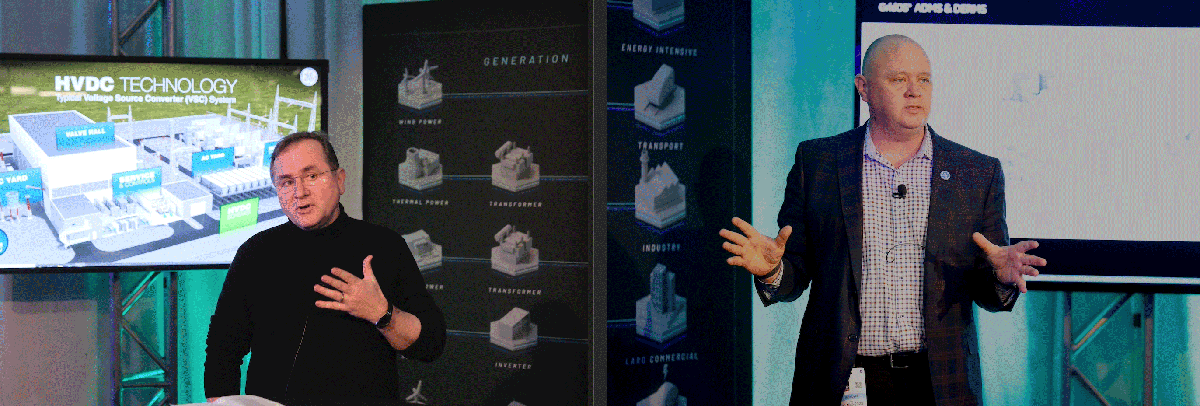Electrical power systems, better known as the grid, have largely worked the same way for more than 100 years. The vast network of wires, switches, transformers, and other technologies were designed for a one-way power flow, moving electrons from the point of generation to the point of consumption. Today, rapid changes are putting tremendous pressure on the grid. Electricity is no longer flowing in one direction only. You might think of it as a free-for-all — from the intermittent flows of big wind and solar projects to rooftop solar panels to an EV in the driveway. Add to that complexity the increasing threats from severe weather events and cybersecurity. All this is taking place as the demand for energy rises with the electrification of transportation and industry.
These changes make it urgent that technology evolve to make the grid a reliable, resilient, and efficient two-way system. At GE Vernova, GE’s portfolio of energy businesses, we are committed to both decarbonization and electrification and view the electricity grid as the “backbone” to achieving these two goals.
At GE’s recent 2023 Investor Conference, we had the opportunity to share how GE Vernova is innovating technologies that are needed to address the electrification imperative.

Bringing More Renewable Energy Online With High-Voltage Direct Current (HVDC) Systems
Ever since Westinghouse and Tesla beat Edison in the “current wars,” alternating current (AC) has been the dominant method of transmitting power. But with the world projected to add 7,000 gigawatts (GW) over the next 20 years, equivalent to six times the renewable resources now operating, grid operators and governments are increasingly looking at a more efficient way to transmit electricity over long distances: high-voltage direct current, or HVDC.
HVDC systems convert AC to direct current (DC), transmitting the power along a DC line and reconverting it back into AC before connecting to the local grid. Unlike AC systems, DC allows for a uniform circulation of electrons. That reduces electricity losses in the transmission line by up to 50%. HVDC technology can play an important role in bringing the tremendous amount of new capacity online. It’s the most cost-efficient solution to transmit bulk power — meaning up to 2–3 GW at 500,000–800,000 volts — over distances of typically more than several hundreds of miles.
The technology’s long-distance transmission ability makes it ideal for projects like offshore wind systems. GE’s HVDC system solution is being used for some of the largest such projects, like DolWin3, where it is moving electricity through almost 100 miles of subsea and terrestrial cable from turbines spinning in the North Sea to Germany. It’s also being used in an offshore wind farm in England called Sofia, operated by utility giant RWE. All told, the two projects ultimately will enable GE customers to reliably connect more than 2.2 GW of offshore wind generation to local grids.
Two of the most important elements within HDVC systems are the modular multilevel converters, based on voltage-sourced converters (VSC) and the control system. VSCs are composed of valves using modern power electronics called IGBTs (insulated-gate bipolar transistors), capable of self-commutating at very high speed, within a broad bandwidth of frequencies, and can easily reverse the power flow. VSC enables black start in case of a defective AC grid and even provides stability to a weak AC grid. The control system is a high-capacity data-acquisition and protection-and-control platform. It collects and analyzes thousands of data points to control the 60 million IGBT switching operations per second, with a microsecond’s accuracy. With our latest eLumina controls platform, we are leveraging digitized data and a modular software architecture to provide greater system resiliency, redundancy, and availability.
Some 25 years ago, broadband telecommunications was commonly called the information superhighway. Nowadays, HVDC is the electron superhighway.
Preparing for Increasing Weather and Cyber Threats
In many places, the grid is already being pushed beyond its limits, and threats are increasing. For example, many grids are now seeing twice as many outages due to weather, and the utilities industry has seen a 48% increase in cyberattacks in the past year alone. Grid operators and utilities recognize that software needs to play a bigger role in managing a safe, secure, and reliable grid.
GE Digital recently launched GridOS, the world’s first end-to-end grid software portfolio designed for grid orchestration. GridOS helps transmission operators see and predict the flow of electrons from both conventional and renewable sources, thereby enabling the grid to remain stable. Its weather planning and recovery applications help utilities see the weather coming, understand its impact on their operation, analyze scenarios to manage it, and recover quickly if faced with an outage. As a result, our customers experience 18% fewer network outages and realize 40% faster restoration times.* To address customers’ cybersecurity needs, GridOS has a “zero trust” security model built in, to secure the grid against threats from both outside and inside, enabling utilities to be compliant with the toughest security standards right from the start.
The Electrification of Transportation and Industry
The correlation between rising electricity demand, which is expected to triple by 2050, and electrification cannot be disputed. The International Energy Agency projects that 50% of worldwide power investments will be dedicated to the grid through 2030, driven by growing renewables integration, distributed energy resources expansion, and decarbonization of energy-intensive applications via electrification.
To ensure a more reliable and more secure grid, this level of complexity must be managed with advanced technology and software solutions, such as GE’s HVDC, flexible alternating current transmission systems, and GridOS, to succeed in both electrification and decarbonization for today and the future.
Philippe Piron is president and CEO of GE Grid Solutions and Power Conversion. Scott Reese is president and CEO of GE Digital.
* Data from Electric Power Industry Report, Form EIA-861, October 2022, results based on utilities in the United States that have 1.25 million customers or more. Reliability data shows average SAIDI and SAIFI with MED. Source: Annual Electric Power Industry Report, Form EIA-861 detailed data files. Claim notes: The report is based on reliability data; no calculations or assumptions were done. Data is from the U.S. Energy Information Administration: “The U.S. Energy Information Administration (EIA) is a principal agency of the U.S. Federal Statistical System responsible for collecting, analyzing, and disseminating energy information to promote sound policymaking, efficient markets, and public understanding of energy and its interaction with the economy and the environment.”
